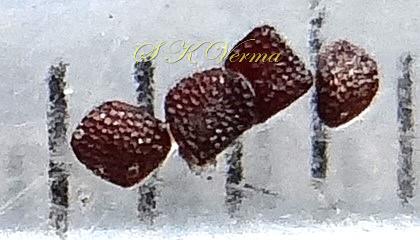HAMELIA
Hamelia
Jacq., Enum. Syst. Pl.: 2. 1760; Benth. & Hook. f., Gen. Pl. 2: 76. 1873; Bailey, Stand. Cycl. Hort. 2: 1431. 1950; Bor & Raizada, Beaut. Ind. Climb. Shr. and Trees. 95. 1954; Standley & Williams, Fl. Guat. 9 (1-3): 90. 1975; Chen & Taylor, Fl. China @ eFloras.org 19: 147; Nazim. & Qaiser, Fl. Pak. @ eFloras.org p. 6.
Evergreen shrubs or small trees; unarmed. Leaves opposite or verticellate, petiolate, entire; stipules interpetiolar, triangular, caducous or persistent. Inflorescence a terminal di- or trichotomous scorpoid cyme or panicle, many flowered, bracteate or bracts reduced. Flowers bisexual, sessile or subsessile. Hypanthium ovoid or turbinate. Calyx 5-lobed, lobes elliptic, short, erect, persistent. Corolla red to orange or yellow, tubular or campanulate, 5-lobed, 5-ribbed, imbricate in bud, throat glabrous. Stamens 5, inserted at the base of corolla tube, included or partially exserted; filaments short; anthers linear-oblong, basifixed and entire or dorsifixed and sagittate (2-lobed at base), with connective flattened and prolonged at apex. Ovary inferior, 5-locular, ovules numerous on axile placentas; style fusiform; stigma 1-5, linear to clavate, obtuse. Fruit a small berry with persistent calyx. Seeds numerous, small, irregularly angled to lenticular.
16 species
Hamelia patens
Hamelia patens
Jacq., Enum. Syst. Pl.: 16. 1760; Cooke, Fl. Pres. Bomb. 2: 626. 1902; Parker, For. Fl. Punj. ed. 1: 284. 1918 (Reprint 1973); ed. 2: 289. 1924; Bailey, St. Cycl. Hort. 2: 1431. 1950; Bor & Raizada, Beaut. Ind. Climb. Shr. and Trees. 96. 1954; Standley & Williams, Fl. Guat. 9 (1-3): 93. 1975; Fl. China @ eFloras.org 19: 147; Nazim. & Qaiser, Fl. Pak. @ eFloras.org p. 7.
A large evergreen perennial shrub or a small tree up to 3 m or more, puberulous; young branches angular. Leaves in whorls of 3-4, rarely opposite, 3-14 cm x 2-5 cm, elliptic-oblong or oblong-obovate, shortly acuminate, base narrowed, margin entire, puberulous on both sides, especially on nerves, lateral nerves 6-8 pairs, arcuate, prominent beneath, purplish red, especially midvein; petiole 1-2 cm long, puberulous, purplish red; stipules interpetiolar, narrowly triangular to subulate, ca. 3 mm long. Flowers bisexual, actinomorphic, pentamerous, epigynous, 2-2.5 cm long, scarlet to orange in terminal pedunculate (peduncle 1-8 cm) panicles, consisting of a whorl of 3-4 branches and one central branch, each branch usually once forked with a solitary flower between two scorpoid axes on which the secund, very shortly pedicellate (pedicel ca. 1 mm long) flowers are borne; axes scarlet, angular, puberulous; bracts reduced triangular, 0.2-0.5 mm. Hypanthium/ calyx tube campanulate, ca. 4 mm long, puberulous; lobes 5, minute, 0.8-1 mm long, deltoid, valvate; calyx red. Corolla scarlet to orange, ca. 2 cm long, tubular, angular, 5-ribbed, shortly 5-lobed, lobes ovate-triangular, 1-2 mm, acute, puberulous. Stamens 5, inserted below the middle of corolla tube; anthers linear, ca. 10 mm long, basifixed, sagittate; filaments short, ca. 2-3 mm long. Ovary surrounded by thick conical disc. Ovary inferior, 5-locular, ovules numerous on axile placentas; style filiform, 1-1.5 cm long; stigma simple, clavate, obtuse, ca. 3 mm long. Fruit ellipsoid-oblong or globose berry, 6-8 mm long and broad, red in colour, puberulent to glabrous. Seeds small, brown or yellowish brown.
Common Names: Firebush, Hummingbird Bush, Scarlet Bush, Redhead, Firecracker Bush, Hamelia
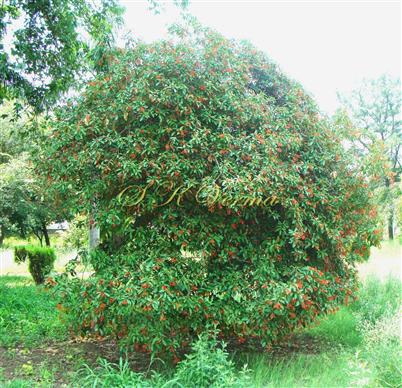
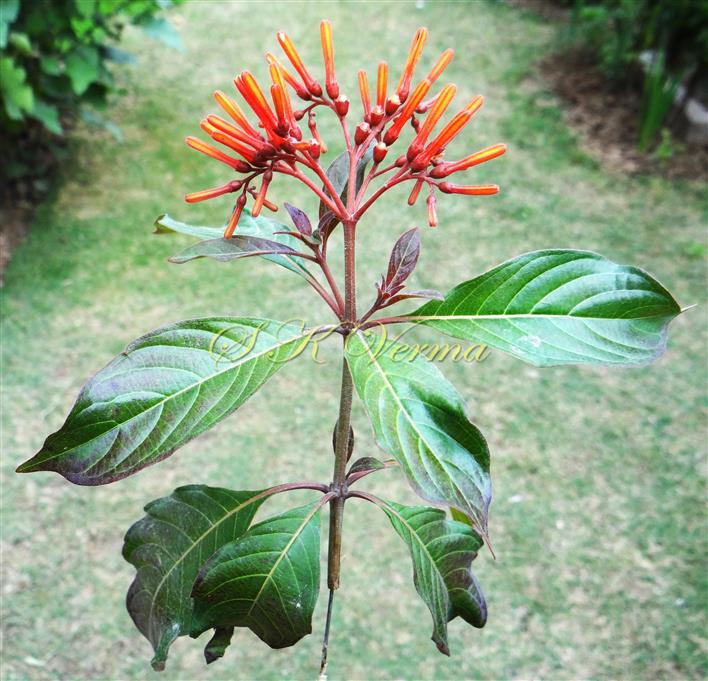
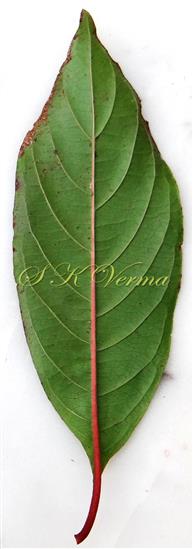
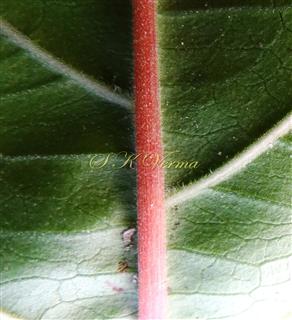
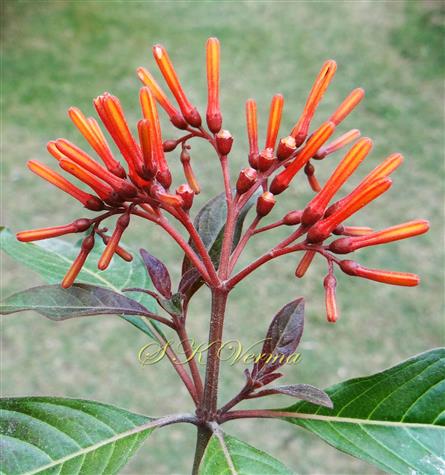
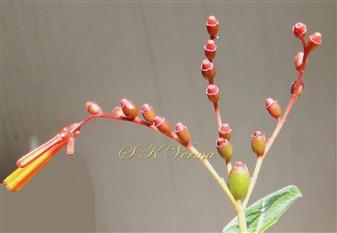
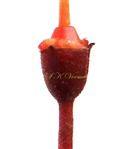
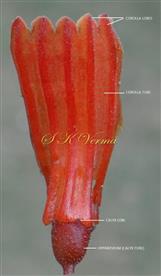
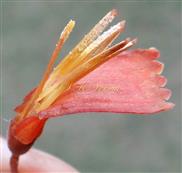
 and stamens-DSC00179.jpg)
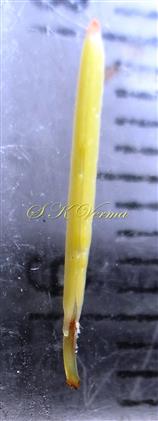
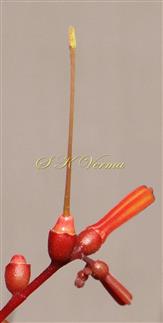
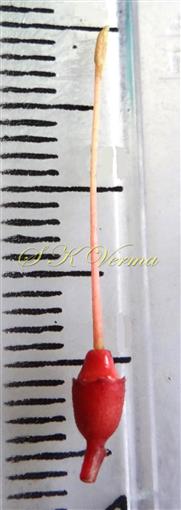
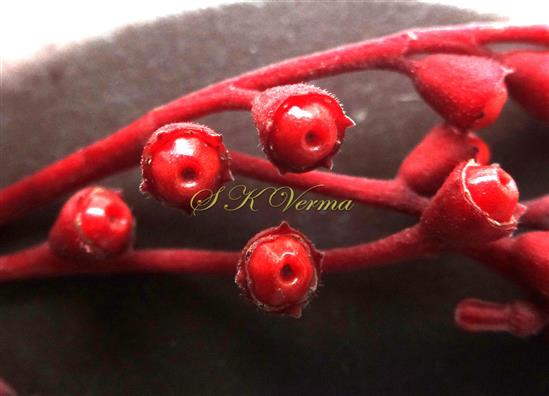
.jpg)
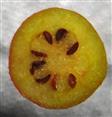











 and stamens-DSC00179.jpg)




.jpg)

